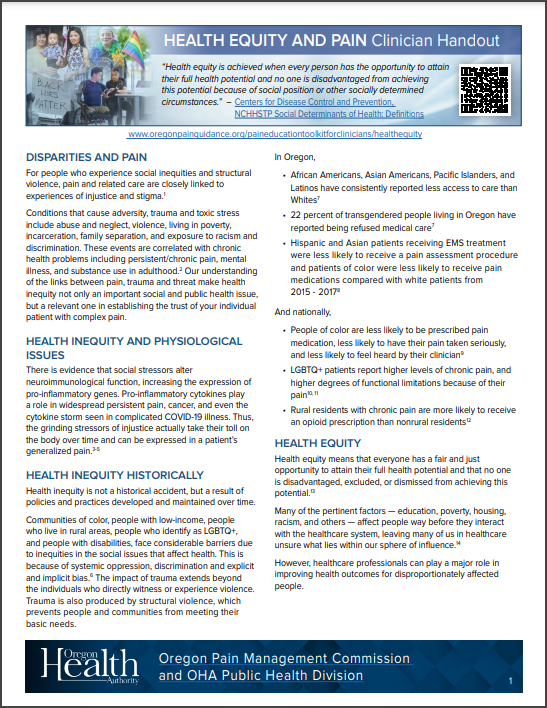HEALTH EQUITY
Health equity means that everyone has a fair and just opportunity to attain their full health potential and that no one is disadvantaged, excluded, or dismissed from achieving this potential. Many of the pertinent factors — education, poverty, housing, racism, and others — affect people way before they interact with the healthcare system, leaving many of us in healthcare unsure what lies within our sphere of influence. However, healthcare professionals can play a major role in improving health outcomes for disproportionately affected people.
DISPARITIES AND PAIN
For people who experience social inequities and structural violence, pain and related care are closely linked to experiences of injustice and stigma. Conditions that cause adversity, trauma and toxic stress include abuse and neglect, violence, living in poverty, incarceration, family separation, and exposure to racism and discrimination. These events are correlated with chronic health problems including persistent/chronic pain, mental illness, and substance use in adulthood. Our understanding of the links between pain, trauma and threat make health inequity not only an important social and public health issue, but a relevant one in establishing the trust of your individual patient with complex pain.
HEALTH INEQUITY AND PHYSIOLOGICAL ISSUES
There is evidence that social stressors alter neuroimmunological function, increasing the expression of pro-inflammatory genes. Pro-inflammatory cytokines play a role in widespread persistent pain, cancer, and even the cytokine storm seen in complicated COVID-19 illness. Thus, the grinding stressors of injustice actually take their toll on the body over time and can be expressed in a patient’s generalized pain.
 VIDEO
VIDEO
The Health Equity video:
- Explains how health inequities can affect the pain people experience and how they are treated
- Explains that adversity, trauma, and toxic stress have a lifelong effect on health
- Encourages us to educate ourselves as individuals and organizations and to become part of the solution
The video contains all the educational content, so be sure to have the patient watch the entire video.
 HANDOUT
HANDOUT
This handout:
- Defines “Health Equity” and explains how disparities can influence pain
- Provides statistics for Oregon and national showing bias in healthcare treatment
- Suggests the role that healthcare providers and organizations can play to address health inequities
- Recommends several nationally recognized training programs and resources on equity-oriented healthcare
 RESOURCES
RESOURCES
- Wallace, B., Varcoe, C., Holmes, C. et al. Towards health equity for people experiencing chronic pain and social marginalization. Int J Equity Health 20, 53 (2021). https://doi.org/10.1186/s12939-021-01394-6
- Centers for Disease Control and Prevention, Violence Prevention, Adverse Childhood Experiences https://www.cdc.gov/violenceprevention/aces/riskprotectivefactors.html
- Cole, Steven. Human Social Genomics, PLOS Genetics Aug 2014, Vol 10, Issue 8 https://doi.org/10.1371/journal.pgen.1004601
- Atzeni F et al. Il-6 Involvement in pain, fatigue and mood disorders in rheumatoid arthritis and the effects of Il-6 inhibitor sarilumab. Pharmacol Res. 2019 Nov;149:104402. doi: 10.1016/j.phrs.2019.104402. Epub 2019 Sep 16. PMID: 31536783.
- Shintaro H. How COVID-19 induces cytokine storm with high mortality. Inflamm Regen Nov 2019, Vol 149 doi: 10.1186/s41232-020-00146-3
- Healthier Together Oregon: State Health Improvement Plan 2020 – 2024 https://healthiertogetheroregon.org/
- Speaker of the House Tina Kotek’s testimony to the House Committee on Healthcare, April 2, 2019: https://www.oregon.gov/oha/OEI/Pages/CCCE.aspx
- Kennel, Jamie MAS; Withers, Elizabeth MS; Parsons, Nate MS; Woo, Hyeyoung PhD. Racial/Ethnic Disparities in Pain Treatment, Medical Care: December 2019 – Volume 57 – Issue 12 – p 924-929 doi: 10.1097/ MLR.0000000000001208
- Meghani SH, Byun E, Gallagher RM. Time to take stock: a meta-analysis and systematic review of analgesic treatment disparities for pain in the United States. Pain Med 2012;13:150-174.
- The Joint Commission. Advancing effective communication, cultural competence and patient and family centered care for the lesbian, gay, bisexual and transgender (LGBT) community: a field guide. 2014. Oakbrook Terrace, Illinois: The Joint Commission. http://www.jointcommission.org/lgbt/default.aspx
- Case P, Austin SB, Hunter DJ, et al. Sexual orientation, health risk factors, and physical functioning in the Nurses’ Health Study II. J Womens Health. 2004;13:1033–1047. https://doi.org/10.1089/jwh.2004.13.1033
- Prunuske JP, St Hill CA, Hager KD, Lemieux AM, Swanoski MT, Anderson GW, Lutfiyya MN. Opioid prescribing patterns for non-malignant chronic pain for rural versus non-rural US adults: a population-based study using 2010 NAMCS data
- The Prevention Institute, Health Equity and Racial Justice: https://www.preventioninstitute.org/focus-areas/healthequity
- Mate K, Wyatt R. Health equity must be a strategic priority. NEJM Catalyst. January 4, 2017. https://catalyst.nejm.org/ doi/full/10.1056/CAT.17.0556
- Ford-Gilboe, Marilyn et al. “How Equity-Oriented Healthcare Affects Health: Key Mechanisms and Implications for Primary Healthcare Practice and Policy.” The Milbank quarterly vol. 96,4 (2018): 635-671. doi:10.1111/1468-0009.12349
- Institute of Medicine Relieving Pain in America: A Blueprint for Transforming Prevention, Care, Education, and Research: https://www.nap.edu/catalog/13172/ relieving-pain-in-america-a-blueprint-for-transformingprevention- care
- Wyatt R, Laderman M, Botwinick L, Mate K, Whittington J. Achieving Health Equity: A Guide for Healthcare Organizations. IHI White Paper. Cambridge, Massachusetts: Organizations. IHI White Paper. Cambridge, Massachusetts: Institute for Healthcare Improvement; 2016. http://www.ihi.org/resources/


